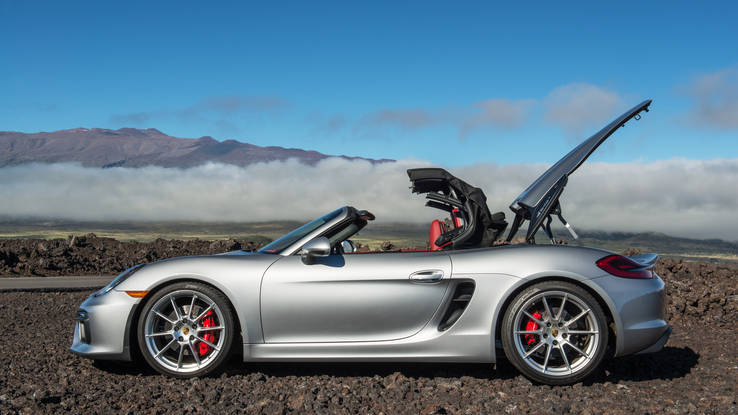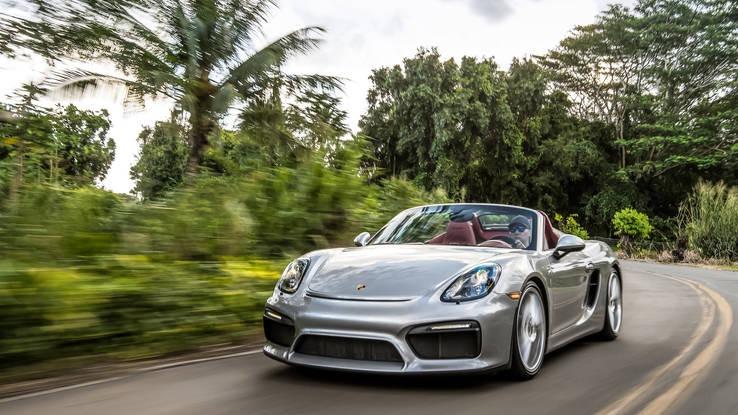The most old-fashioned car in Porsche’s lineup may also be our favorite
What is it?
There are at least a couple of ways to dissect the 2016 Porsche Boxster Spyder. Depending on your point of view, it’s either a ludicrously high-dollar take on Porsche’s entry-level roadster or the latest shot at a hot rod by way of Zuffenhausen — the purest, most analog embodiment of what we might call the Porsche spirit offered new on the market today.
Thing is, you’re not wrong either way you slice it. The newest Boxster Spyder is both expensive enough to give you pause and so good that you probably won’t care. It’s the sort of car that hits all the right notes with the purists and seems destined to mine new brand fanatics on its way up the scale. But before you accuse us of gushing, take a look at the specs; they never tell the whole story, but in this case, they say a lot.
For one, you’re shoving what may be one of the 911’s last naturally aspirated gasps — the 3.8-liter flat-six yanked from the first-gen 991 Carrera S and also found in the Cayman GT4 — into the lightest platform in its stable, and pairing it exclusively with a six-speed manual transmission. Here, it’s good for 375 hp and 309 lb-ft of torque and a stated 0-60 mph of 4.3 seconds. Would a PDK be quicker around a certain German racetrack? Almost certainly, but that’s totally not the point of this car.

The last Boxster Spyder’s top was best described as finicky (that’s a technical term); for 2016, the deployment procedure is greatly simplified.
The Spyder also ditches the standard-issue top in favor of an even less-substantial roof that’s not only 24 lbs lighter than the regular Boxster’s canvas (no sound insulation here!), but also significantly easier to deploy than the one on the last Spyder. It took 15 steps to put in place and/or tuck away the previous Spyder’s canvas cover, all of them said to be somewhat awkward; this time around, it takes just six to execute either procedure, and it’s all been significantly streamlined (read: idiot-proofed).
The barely-mechanized process isn’t as simple or fluid as the new Miata’s stoplight-length solo effort, but neither is it a philosophical departure like the slick-but-over-engineered Transformer top of the new 911 Targa. It’s a nod to practicality and a happy compromise, one of the very few found on the car. Plus, you can leave it in place all the way up to the 180 mph top speed — not advisable on the previous car — and it’s also carwash-safe.
Like the engine, the steering setup has been borrowed from elsewhere in the Porsche lineup (in this case, the 911 Turbo) and the brake calipers and rotors come from the 911 Carrera S. The Boxster GTS’ optional sport suspension, standard here, drops ride height 0.79 inches, but Porsche is quick to tell you that this is a two-seat tourer built for the road first and foremost; the setup is less harsh and track-oriented than, say, the Cayman GT4’s. 20-inch wheels are Spyder-exclusive, and the 10.5-inch rears are the widest ever installed on a Boxster.
In the interest of saving even more weight and projecting an appropriately hardcore image, the Boxster Spyder’s interior door handles have been replaced with cloth pulls and the radio and air conditioner do not come standard (they are, however, no-cost options).

Meanwhile, on the surface of Mars…
What’s it like to drive?
Porsche decided to give us our first taste of the Boxster Spyder on Hawaii’s primeval Big Island, which seemed, at first, to be a questionable choice: We’d been told that the roads were less interesting than the scenery and warned that the cops were keen on enforcing that laid-back, slow-paced vibe.
But there’s one old ranch two-lane, Saddle Road, that cuts right across the island’s interior. It’s a well-paved string of rapid elevation changes and dramatic crests that leave you absolutely sure you’re going to launch into the clouds until you plunge into the next off-camber blind corner. It’s probably one of the best public roads we’ve driven all year, and to top it all off, there wasn’t a tourist in a rental Camaro in sight.
This — the fabled spirited drive down a quiet backcountry road — is what the Boxster Spyder was built for. The car/road pairing was laugh-out-loud good. We ended up blasting up and down that stretch of asphalt in mostly third, or hell, even second gear, the motor wailing wonderfully the whole way. Save for the one time we drove a little faster than we could see and felt the traction and stability control kick in, and for a fraction of a second at that, the car never lost its balance or poise. A hundred-odd miles (or a third of a tank of fuel, give or take) have never seemed to pass so quickly.
The hours spent cruising the perimeter of the island weren’t too bad, either. Tropical paradise, new convertible — you add it up. The occasional friendly shaka sign thrown by drivers as we passed (again, probably screaming by in third gear) completed the Hawaiian experience. And Porsche was right: Despite the sporty suspension and lower ride height, the car is set up more like a tourer; never once was it rough or harsh. Granted, Hawaii’s roads are near-perfect compared to, say, Detroit’s, but the exhaust note and wind/road noise are more likely to wear you down on an extended drive than the ride quality. Then again, if you don’t like wind and road noise, don’t get a convertible, and if you can’t abide a great exhaust note, then definitely don’t get this convertible.
The Boxster Spyder doesn’t come off as a car cobbled together around a motor — it’s too refined for that. But the 3.8-liter is so good that it’s a shame it’s tucked away amidships, never to be viewed and appreciated by the average owner. Your author hasn’t yet driven the new small-t turbo 911s, but he’s been assured (by both Porsche personnel and ostensibly objective car-writers) that their ample, instantly delivered torque is addictively good. Good enough to make this naturally aspirated six seem a little old-fashioned, even. You have to wind up all the way to 6,700 rpm to achieve peak output, after all, and you don’t get the benefit of all 309 lb-ft of torque until 4,750 rpm. Likewise, a PDK would make this car both faster and even more effortless to drive.
When you’ve got a motor and a sound like this, though — and a gearbox this tight and crisp — it’s tough figuring out what’s wrong with being a little bit old-fashioned.

Tropical island paradise, powerful new German convertible. The perfect pairing?
Do I want it?
With go-fast and stop-fast bits grabbed from across the Porsche lineup and crammed into the automaker’s lightest offering, the Boxster Spyder follows the classic hot rod forumla — executed, naturally, with classic German precision. The spyder top, like the transmission, remain wonderfully analog. Yet it also gains a measure of practicality (you can take it through the car wash, after all) and a gloriously ass-kicking motor. Of course you want it…
…except that things might to get a little tricky for you when you start pricing one out.
You can get a 911 Carrera for a little as $ 90,395 (theoretically). The Boxster Spyder starts at $ 83,095. Start checking boxes — optional paint and a fancy audio package, perhaps — and you’re getting dangerously close to 911 territory. You’ll be tempted, maybe, to “upgrade.” Certainly, even a base 911 is a very good car by any objective measure.
Our advice: Stay the course and get the Boxster Spyder. It sits at maybe the optimal point between the raw, hairy Porsches of James Dean’s past and the hypercar science experiments of Porsche’s turbocharged, hybridized future. It’s the kind of car we’re less and less likely to see down the road, especially from Stuttgart. To compare it to the ever-evolving, ever-improving 911 is to miss the point entirely.
Sure, 911 nuts might look at you sideways because you could have bought the car but you got this thing instead. You won’t care, because you’ll be blasting away from them, probably in second gear, in the driver’s seat of a Boxster Spyder. And the driver’s seat of a Boxster Spyder is a very, very nice place to be.





























